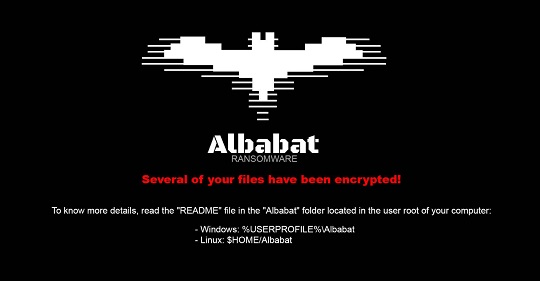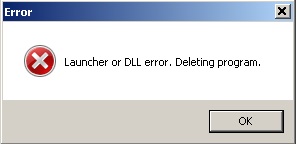Ransom.Win64.ALBABAT.THLAABC
UDS:Trojan-Ransom.Win32.Encoder.vkr (KASPERSKY); Ransom:Win64/Albabat.YAA!MTB (MICROSOFT)
Windows


Threat Type: Ransomware
Destructiveness: No
Encrypted: No
In the wild: Yes
OVERVIEW
This Ransomware arrives on a system as a file dropped by other malware or as a file downloaded unknowingly by users when visiting malicious sites.
It encrypts files found in specific folders. It drops files as ransom note. It avoids encrypting files with the following file extensions.
TECHNICAL DETAILS
Arrival Details
This Ransomware arrives on a system as a file dropped by other malware or as a file downloaded unknowingly by users when visiting malicious sites.
Installation
This Ransomware drops the following files:
- %Application Data%\Protect\S-3-5-25-0067212291-1140412766-535520311-1000\23aa4cc77f591dfc237480bbd95f6ba_84bd4d53-ac30-4946-a8d6-0787bbe453
- %User Profile%\Albabat\Albabat.log
- %User Profile%\Albabat\Albabat.ekey
- %User Profile%\Albabat\www\banner.jpg
- %User Profile%\Albabat\www\faq.html
- %User Profile%\Albabat\www\style.css
- %User Profile%\Albabat\www\script.js
- %Desktop%\Albabat.lnk → shortcut to open the ransom note
(Note: %Application Data% is the current user's Application Data folder, which is usually C:\Documents and Settings\{user name}\Application Data on Windows 2000(32-bit), XP, and Server 2003(32-bit), or C:\Users\{user name}\AppData\Roaming on Windows Vista, 7, 8, 8.1, 2008(64-bit), 2012(64-bit) and 10(64-bit).. %User Profile% is the current user's profile folder, which is usually C:\Documents and Settings\{user name} on Windows 2000(32-bit), XP, and Server 2003(32-bit), or C:\Users\{user name} on Windows Vista, 7, 8, 8.1, 2008(64-bit), 2012(64-bit) and 10(64-bit).. %Desktop% is the current user's desktop, which is usually C:\Documents and Settings\{User Name}\Desktop on Windows 2000(32-bit), XP, and Server 2003(32-bit), or C:\Users\{user name}\Desktop on Windows Vista, 7, 8, 8.1, 2008(64-bit), 2012(64-bit) and 10(64-bit).)
It creates the following folders:
- %Application Data%\Protect\S-3-5-25-0067212291-1140412766-535520311-1000
- %User Profile%\Albabat
- %User Profile%\Albabat\www
(Note: %Application Data% is the current user's Application Data folder, which is usually C:\Documents and Settings\{user name}\Application Data on Windows 2000(32-bit), XP, and Server 2003(32-bit), or C:\Users\{user name}\AppData\Roaming on Windows Vista, 7, 8, 8.1, 2008(64-bit), 2012(64-bit) and 10(64-bit).. %User Profile% is the current user's profile folder, which is usually C:\Documents and Settings\{user name} on Windows 2000(32-bit), XP, and Server 2003(32-bit), or C:\Users\{user name} on Windows Vista, 7, 8, 8.1, 2008(64-bit), 2012(64-bit) and 10(64-bit).)
Other System Modifications
This Ransomware changes the desktop wallpaper by modifying the following registry entries:
HKEY_CURRENT_USER\Control Panel\Desktop
Wallpaper = %User Profile%\Albabat\wallpaper_albabat.jpg
It sets the system's desktop wallpaper to the following image:
- %User Profile%\Albabat\wallpaper_albabat.jpg

Other Details
This Ransomware does the following:
- It displays a fake error message box and will proceed to its malicious routine once the window is closed:

- It moves the initially executed sample to the Application Data folder:
- %Application Data%\{Malware Name}.exe
Ransomware Routine
This Ransomware encrypts files found in the following folders:
- %User Profile%\Pictures
- %User Profile%\Imágenes
- %User Profile%\Imagens
- %User Profile%\Documents
- %User Profile%\Documentos
- %User Profile%\OneDrive\Pictures
- %User Profile%\OneDrive\Images
- %User Profile%\OneDrive\Imágenes
- %User Profile%\OneDrive\Imagens
- %User Profile%\OneDrive\Área de Trabalho
- %User Profile%\OneDrive\Área de trabajo
- %User Profile%\OneDrive\Desktop
- %User Profile%\OneDrive\Documents
- %User Profile%\OneDrive\Documentos
- %User Profile%\OneDrive\Contacts
- %User Profile%\OneDrive\Contactos
- %User Profile%\OneDrive\Cofre Pessoal
- %User Profile%\OneDrive\Personal Safe
- D:\Pictures
- D:\Images
- D:\Imágenes
- D:\Imagens
- D:\Documents
- D:\Documentos
- %Public%\Documents
- %Public%\Pictures
- %User Profile%\CLionProjects
- %User Profile%\IntelliJProjects
- %User Profile%\RustroverProjects
- %User Profile%\Desktop
- %User Profile%\OneDrive
- %User Profile%
- A:\
- B:\
- E:\
- F:\
- G:\
- H:\
- I:\
- X:\
- D:\
- %User Profile%\Downloads
- D:\Downloads
(Note: %User Profile% is the current user's profile folder, which is usually C:\Documents and Settings\{user name} on Windows 2000(32-bit), XP, and Server 2003(32-bit), or C:\Users\{user name} on Windows Vista, 7, 8, 8.1, 2008(64-bit), 2012(64-bit) and 10(64-bit).. %Public% is the folder that serves as a repository of files or folders common to all users, which is usually C:\Users\Public in Windows Vista, 7, and 8.)
It avoids encrypting files with the following strings in their file name:
- NTUSER.DAT
- Albabat.ekey
- Albabat.key
- wallpaper_albabat.jpg
- README.txt
- FAQ.txt
- privkey.pem
- Thumbs.db
- .DS_Store
It avoids encrypting files found in the following folders:
- Searches
- AppData
- System Volume Information
- steamapps
- ansel
- tmp
- node_modules
- cache
- tkinter
- tcl
- vendor
- target
- venv
- env
- Mozilla
- Chrome
- pypoetry
- vimfiles
- viminfosite-packages
- scoop
- go
It drops the following file(s) as ransom note:
- %User Profile%\Albabat\README.html

It avoids encrypting files with the following file extensions:
- .abbt
- .pyd
- ._pth
- .CHK
- .pickle
- .url
- .tmp
- .dat
- .exe
- .lnk
- .win
- .bin
- .cab
- .inf
- .lib
- .tcl
- .cat
- .so
- .msi
- .vpk
- .vc
- .cur
- .ini
- .bik
- .sfx
- .xnb
- .ttf
- .otf
- .woff
- .woff2
- .vfont
- .resource
- .N2PK
- .log
- .pkg
- .desktop
- .dll
- .pkr
- .arc
- .sig
- .bk2
- .arz
- .swf
- .qt
- .wma
- .mp2
- .vdf
- .pdb
- .nfo
- .whl
SOLUTION
Step 1
Trend Micro Predictive Machine Learning detects and blocks malware at the first sign of its existence, before it executes on your system. When enabled, your Trend Micro product detects this malware under the following machine learning name:
-
ADW.Win32.TRX.XXPE50FFF076
Step 2
Before doing any scans, Windows 7, Windows 8, Windows 8.1, and Windows 10 users must disable System Restore to allow full scanning of their computers.
Step 3
Note that not all files, folders, and registry keys and entries are installed on your computer during this malware's/spyware's/grayware's execution. This may be due to incomplete installation or other operating system conditions. If you do not find the same files/folders/registry information, please proceed to the next step.
Step 4
Search and delete this file
- %Application Data%\Protect\S-3-5-25-0067212291-1140412766-535520311-1000\23aa4cc77f591dfc237480bbd95f6ba_84bd4d53-ac30-4946-a8d6-0787bbe453
- %User Profile%\Albabat\Albabat.log
- %User Profile%\Albabat\Albabat.ekey
- %User Profile%\Albabat\wallpaper_albabat.jpg
- %User Profile%\Albabat\www\banner.jpg
- %User Profile%\Albabat\README.html
- %User Profile%\Albabat\www\faq.html
- %User Profile%\Albabat\www\style.css
- %User Profile%\Albabat\www\script.js
- %Desktop%\Albabat.lnk
- %Application Data%\{Malware Name}.exe
Step 5
Search and delete these folders
- %Application Data%\Protect\S-3-5-25-0067212291-1140412766-535520311-1000
- %User Profile%\Albabat
- %User Profile%\Albabat\www
Step 6
Reset your Desktop properties
Step 7
Scan your computer with your Trend Micro product to delete files detected as Ransom.Win64.ALBABAT.THLAABC. If the detected files have already been cleaned, deleted, or quarantined by your Trend Micro product, no further step is required. You may opt to simply delete the quarantined files. Please check the following Trend Micro Support pages for more information:
Step 8
Restore encrypted files from backup.
Did this description help? Tell us how we did.


